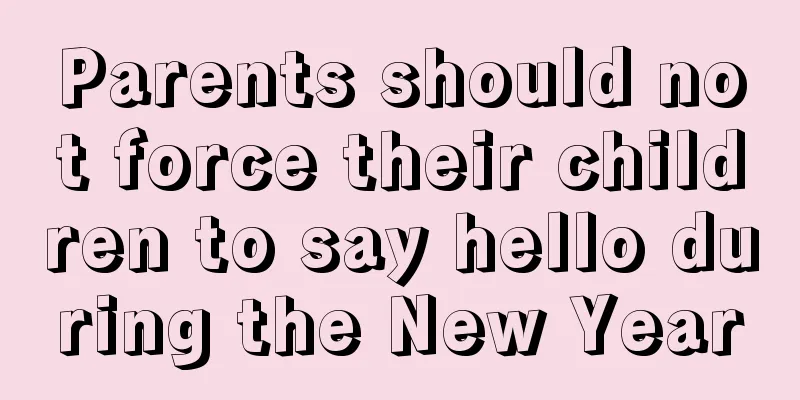What are the symptoms of baby eczema? What should I do if my child has cold hands and feet?

|
The skin of newborn babies is tender and sensitive. Many babies will have eczema. This is a very normal phenomenon. Babies are weak and general treatment methods are not effective. So what are the symptoms of baby eczema? What should I do if my child's hands and feet are cold? What are the symptoms of baby eczemaEczema is one of the most common skin diseases in babies. It is generally believed to be related to genetics, allergic constitution, neurological function and physical factors. It is more common on the forehead, cheeks, and top of the head, and then gradually spreads to the neck, shoulders, back, buttocks, limbs, and even to the whole body. In the early stage of eczema, there are scattered or clustered small red papules, which gradually increase in number, and small blisters, yellow-white scales and crusts can be seen, which may have exudation, erosion and secondary infection. Babies are often irritable, scratching everywhere, and crying at night. The nursing mother can stop eating foods rich in foreign proteins such as eggs, and the baby's eczema may gradually alleviate. Do not use soap or hot water to wash the eczema area, avoid sun exposure, avoid direct contact between woolen clothes or other chemical fiber fabrics and the skin, and do not use drugs on the local skin at will. Different treatments can be taken for eczema at different stages: in the acute stage, 1%~4% boric acid solution can be used for wet compresses or Rafnol zinc oxide ointment can be applied externally; in the subacute stage, take a bath with warm water once a night, and then apply calamine lotion externally to relieve itching and inflammation; in the chronic stage, wash the skin with warm water, and apply 0.5% cortisone cold cream or bran oil ointment externally. If the itching is severe, appropriate amounts of chlorpheniramine, diphenhydramine and other drugs can be used to calm, relieve itching and desensitize. What to do if your child has cold hands and feet1. Keep warm: If the baby's hands and feet are cold, parents should first check whether the baby is wearing too little. As long as the nose tip and the back of the head are warm, the baby is not cold. Pay special attention to keeping the legs and feet warm. If the lower limbs are well kept warm, the whole body will feel warm. Don't wear clothes that are too tight, because tight clothes will hinder blood circulation. Proper exercise can increase blood circulation and metabolism. In addition, if you cover your baby too tightly, it can easily cause illness. 2. Adjust the indoor temperature: If the baby lives in a suitable temperature and humidity environment, his hands and feet will not get cold. If there is an air conditioner at home, it is best to adjust the temperature to around 20℃. If the temperature is too high, the child will often sweat and it is easy to cause illness. 3. Cold hands and feet caused by fever: When a baby has a fever, his hands and feet are often cold. At this time, the palms of the hands and soles of the feet are dry and without sweat. You can feel the fever when you touch the child's forehead with the back of your hand. You must see a doctor in time. 4. Cold hands and feet caused by illness: Some diseases can affect the baby's blood circulation, such as anemia, heart disease, malnutrition, etc. Parents should pay attention to seek medical treatment in time. At the same time, they should also pay attention to observe whether the baby has pale complexion, cyanosis of lips, weak crying, less activity and easy fatigue. Can newborns use belly button stickers?1. Generally, the umbilical cord of a newborn has not fallen off or has just fallen off not long ago. At this time, you can use a belly button sticker to protect it. 2. After the fetus is born, the umbilical cord is tied and cut, leaving a blue-white stump. After a few hours, the stump turns brown-white. Then it gradually dries, becomes thinner, and turns black. Generally, the umbilical stump falls off within 3 to 7 days after birth. When the umbilical cord first falls off, the wound surface is red and slightly moist, and it heals completely after a few days. 3. It should be noted that the abdomen of a newborn whose umbilical cord has not fallen off should not be immersed in water to avoid contamination of the umbilical cord and infection. The baby should not go into the water. The mother should gently wipe the baby with half-dry gauze. After the wound is completely healed, the baby can be bathed in water, but the baby should not be put directly into the water. Instead, a bath bed should be placed on the bathtub and the baby should sleep on it for bathing. When the baby can sit at 5 or 6 months old, the baby can be directly placed in the water for bathing. 4. When wrapping the baby's whole body with a bath towel, leave the navel exposed and use an alcohol cotton swab to clean the navel from the middle to the outside, keeping it dry and clean. If the navel is red, pus or has an unpleasant odor, you should consult a doctor. 5. Usually, you can apply some talcum powder on the baby's skin wrinkles to make him feel dry and comfortable. Apply skin care oil on the baby's buttocks to prevent urine from irritating the skin and causing diaper rash. 6. Put diapers on the baby and put on clothes. However, the baby should not be wrapped tightly in a "candle bag". His hands and feet should be relaxed and allowed to move freely, which is conducive to breathing and blood circulation, so as to promote growth and development. 7. If the baby's facial skin is dry, you can also apply a small amount of moisturizing oil on the face to keep the skin moist and smooth. It is worth noting that commercially available skin care oils, talcum powders and other baby products can only be used in moderation when the baby's skin is free of any disease. Moreover, these oils or powders cannot be sprinkled directly on the skin of newborns. Sprinkle them on your hands first and then apply them on the baby. How many days should the navel patch be applied to a newborn baby?1. Generally, it needs to be replaced or changed every three days or so, and then it is rarely used. After taking a shower, use a soft towel to gently absorb the water in the belly button and disinfect it with alcohol or iodine. 2. When the umbilical cord falls off: Use an umbilical cord patch to protect the belly button from infection. Generally, it can be used until the wound heals. However, each umbilical cord patch should not be used for more than 12 hours, so mothers must remember to replace it. 3. Use an umbilical patch during vaccination: it is mainly to prevent the wound from contacting water, and it usually only takes 12 hours. 4. Use navel stickers during swimming training: It is mainly used to protect the navel from infection. This sticker can be used when the baby is swimming and can be torn off after each swimming session. It should be used at least until the baby is 3 months old. 5. Use umbilical cord patch to prevent colds: It is mainly used to prevent colds. It can be used in cold weather and a single patch should not be used for more than 12 hours. 6. Use the umbilical cord patch as a Band-Aid: Just use it until the wound heals. If you stop using it before the wound of a 0-1 year old baby heals, it will affect the baby's recovery, and babies at this age are particularly susceptible to other infections. |
Recommend
Will picky eating affect children's intelligence? The harm of picky eating in children
Nowadays, family life is better, and children are...
What should expectant mothers pay attention to in the first three months of pregnancy
If a couple wants to get pregnant quickly, the fi...
What kind of quilt should a newborn baby cover in winter? Where should the quilt cover a newborn baby?
In winter, the weather is cold, and babies need t...
Check whether Bausch and Lomb contact lenses are genuine or fake. Will Bausch and Lomb contact lenses curl up?
The quality of Bausch and Lomb contact lenses is ...
Who is suitable for painless childbirth?
Painless childbirth is a method of delivery that ...
Can Ariel sterilizing liquid be used to wash underwear? How about Ariel sterilizing liquid?
Nowadays, laundry detergent and washing powder ar...
How to do amniocentesis? Who can't do amniocentesis?
Expectant mothers must have heard of this term. T...
What should I pay attention to during the confinement period? What should I eat more during the confinement period?
Everyone must have heard of a lot of food in life...
What are the symptoms before ovulation?
It is easier to get pregnant if you have sex duri...
Is painless childbirth good? The benefits of painless childbirth
Painless childbirth is a method of delivery that ...
What are the causes of miscarriage?
Pregnancy is a wonderful thing, but sometimes it ...
How is dodie diapers? Dodie diapers trial report
In the early stages of parenting, diapers are pro...
How to deal with the relationship between the two children and avoid partiality
The country has fully opened up the second child ...
How long does it take to give birth naturally after taking the painless delivery injection? What are the side effects of painless delivery?
Many female friends are afraid of giving birth be...
How to dress during the confinement period in autumn? Things to note during the confinement period in autumn
With the arrival of the Beginning of Autumn, autu...









